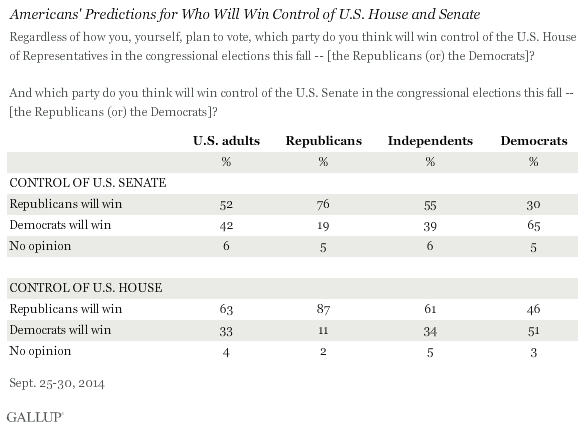PRINCETON, NJ -- Fifty-two percent of Americans say they expect the Republican Party to win in the U.S. Senate, while an even larger majority, 63%, say Republicans will retain their majority in the House of Representatives.

Partisans on both sides show signs of wishful thinking when assessing which party will win control of the U.S. House and Senate this fall. Nearly two-thirds of Democrats interviewed in the Sept. 25-30 survey say their own party will win the Senate -- not an unreasonable conjecture given that Democrats currently control the upper chamber and would need to lose a net of six seats to lose the majority. But the slight majority of Democrats, 51%, also believe their party will win in the House -- an outcome out of step with the Republican gains most pundits are expecting.
Likewise, despite the closeness of several races that Republicans must win if they are to gain control of the Senate, the vast majority of Republicans, 76%, are optimistic the Republicans will take the U.S. Senate. Meanwhile, 87% of Republicans believe the Republican Party will control of the House, possibly reflecting their awareness that their party already has a firm hold on it.
The more objective predictions may be those made by political independents, which mirror the national averages. More than half of independents predict Republicans will win the Senate, and a solid majority -- 61% -- say Republicans will win the House.
All Five Previous House Predictions Have Been Right
This is the first time Gallup has asked Americans about the likely party outcome in the U.S. Senate, and thus it has uncertain value as a forecasting tool. However, as Gallup has noted in the past, Americans' predictions for the U.S. House, albeit limited in number, have been remarkably accurate, aligning with the winning party in all five midterms in which the question was asked. This includes the 2010 and 2006 midterms -- particularly notable since party control changed after both elections -- as well as in three earlier midterms: 1962, 1958, and 1946.

Relatedly, Gallup has also found that Americans as whole have a good track record of predicting which presidential candidate will win the popular vote, forecasting the correct winner in each of the four elections since 1996.
The midterm prediction trend spans relatively few elections, and only two recent ones. However, the results reinforce research that suggests prediction markets (including polls asking the public to predict election outcomes) can be more accurate than other forecasting tools, such as expert predictions, heavily engineered models, and voter-preference polls.
Although Americans are fairly strong in their view that the Republicans will retain control of the House, the new poll finds registered voters are more closely divided in their actual intentions to vote for the Republican versus the Democratic candidate in their congressional district. Forty-seven percent of registered voters say they would vote for the Republican in their district if the election were held today, while 46% would vote for the Democrat. This is similar to what Gallup found in August, but more favorable to the Republicans than in April when the Democrats were ahead by five percentage points, 49% to 44%, respectively.
Political parity on the generic ballot among registered voters is typically a positive sign for Republicans in midterm years. That is because Republican voters tend to turn out in greater numbers than Democratic voters do in these lower-turnout elections.
Republicans' actual turnout advantage in 2014 will be highly dependent on the degree to which Democrats can inspire their base closer to the election. Right now, rank-and-file Republicans are showing about average engagement in the election relative to the past four midterms, while Democrats' attention is somewhat below average.
Bottom Line
Gallup's new question asking Americans who they think will win control of the Senate offers some hope for Republicans, as they lead on this by 10 points, 52% to 42%. But with no trends available for comparison, and control of the Senate likely coming down to a handful of races that are too close to call -- such as in Arkansas, Alaska, Colorado, Louisiana, North Carolina, Kansas, Georgia, and Iowa -- it is not clear how useful this national perceptual measure really is.
An even larger majority of Americans expect the Republicans to retain control of the House, a projected outcome supported by the political parity in registered voters' vote intentions. Still, the Republicans' 33-seat advantage is small by historical standards, and Gallup analysis suggests that Americans' low satisfaction with the direction of the country could fuel high seat turnover. But the conformity of the new poll findings with other important signals -- including President Barack Obama's subpar approval rating, Obama's net-negative effect on voters' choice of candidates, and Republicans' current advantage on several indicators of potential turnout -- adds weight to their significance.
Survey Methods
Results for this Gallup poll are based on telephone interviews conducted Sept. 25-30, 2014, with a random sample of 1,252 adults, aged 18 and older, living in all 50 U.S. states and the District of Columbia.
For results based on the total sample of national adults, the margin of sampling error is ±4 percentage points at the 95% confidence level.
For results based on the sample of 1,095 registered voters, the margin of sampling error is ±4 percentage points at the 95% confidence level.
Interviews are conducted with respondents on landline telephones and cellular phones, with interviews conducted in Spanish for respondents who are primarily Spanish-speaking. Each sample of national adults includes a minimum quota of 50% cellphone respondents and 50% landline respondents, with additional minimum quotas by time zone within region. Landline and cellular telephone numbers are selected using random-digit-dial methods. Landline respondents are chosen at random within each household on the basis of which member had the most recent birthday.
Samples are weighted to correct for unequal selection probability, nonresponse, and double coverage of landline and cell users in the two sampling frames. They are also weighted to match the national demographics of gender, age, race, Hispanic ethnicity, education, region, population density, and phone status (cellphone only/landline only/both, and cellphone mostly). Demographic weighting targets are based on the most recent Current Population Survey figures for the aged 18 and older U.S. population. Phone status targets are based on the most recent National Health Interview Survey. Population density targets are based on the most recent U.S. census. All reported margins of sampling error include the computed design effects for weighting.
In addition to sampling error, question wording and practical difficulties in conducting surveys can introduce error or bias into the findings of public opinion polls.
View survey methodology, complete question responses, and trends.
For more details on Gallup's polling methodology, visit www.gallup.com.
